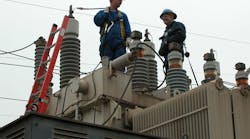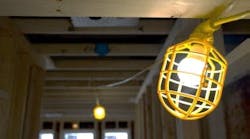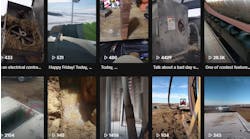I like to save money like everyone else does — well, maybe everyone but my kids. They seem to spend everything they get their hands on, but that’s another story. Training is one area companies inevitably want to save money on. There’s nothing wrong with that, if they get what they pay for, or, more importantly, what they need.
Here’s part of the problem: Many companies don’t know what they should be paying for or what they need. Therefore, Vendor A might come along and say, “You need this,” while Vendor B says, “Oh, that’s not necessary.” Some companies really want to protect their workers; others just want to be able to check off a requirement. Before you read on...Beware: This article is not for those “box checkers.”
What is needed so that the Occupational Safety and Health Administration (OSHA) would consider your people “qualified persons” — that is, people who are exposed to electrical hazards 50V and greater (Photo 1)? This could be electricians, technicians, HVAC technicians, or any other person who works near 50V or more. OSHA doesn’t care about the job title. If your job title is “Chief Bag Carrier” and you work on or near exposed energized electrical conductors or circuit parts, you need to be qualified.
One important distinction to note is that for a qualified person to work on what is considered to be energized circuits or parts, that circuit would have to be both exposed and energized. Therefore, energized equipment that is not exposed would not have the same requirements as equipment that is exposed. It is considered “guarded” (Photo 2) by OSHA and National Fire Protection Association (NFPA) 70E standards and would present no danger — unless you open the door, rack in or out a circuit breaker, or do something else that would expose the energized part inside.
Training resources and considerations
There are two sources that provide training requirements for qualified persons:
- OSHA regulations in 29CFR1910.399, 1910.332, and 1910.333
- NFPA 70E, “Standard for Electrical Safety in the Workplace”
OSHA uses broad, regulatory, non-prescriptive language. In other words, it can be vague if you are not used to using it. NFPA 70E is very prescriptive. The two documents work together to provide a complete picture.
Let’s look at the regulatory requirements first. In 2007, OSHA changed the definition of a qualified person in 1910.399 to read, “Qualified person. One who has received training in and has demonstrated skills and knowledge in the construction and operation of electric equipment and installations and the hazards involved.” Qualified persons must receive training and demonstrate skills and knowledge. The “demonstrate” part is very important because I know at least one OSHA region where they are citing companies for receiving inadequate training. They have classroom training, but no hands-on lab sessions to document demonstrating skills. In my experience, this is an area where a lot of companies are being led astray by some vendors.
Here’s an example. Vendor A offers a training course for qualified persons that contains hands-on labs in addition to the classroom training. Vendor B does not offer the hands-on lab sessions, instead telling the customer that they, “can do that on their own.” There are two issues with this recommendation:
- They probably won’t follow through on that requirement.
- If they do it, they either won’t perform the hands-on properly, or they won’t document it properly.
Joe Pipkin, chief director of the Office of Engineering Safety and past OSHA representative to NFPA 70E committee, once said, “If you don’t document it, you can’t prove you did it.” That same opinion has been voiced by other OSHA compliance officers I know.
When OSHA comes in, it’s show-and-tell time. Getting a slap on the wrist during an OSHA audit is one thing. If someone gets injured because of inadequate training, trying to defend your company’s position in court is an entirely different situation. More and more lawyers are getting wise to the fact that when OSHA conducts accident investigations, lack of training is almost always cited as a “willful violation.” Let’s call that what it is — negligence. When there is negligent behavior on the part of a company that leads to injury or death, that company loses its workman’s compensation protections. In today’s litigious society, this leaves companies vulnerable to lawsuits.
Breaking down specific skills by category
What training do qualified persons have to demonstrate? That is outlined in OSHA 1910.332 and 1910.333 as well as in NFPA 70E Art. 110.6 (2021 edition). At minimum, those working near energized parts must be trained in the following:
1910.332(b)(3)(i) The skills and techniques necessary to distinguish exposed live parts from other parts of electric equipment.
Author’s interpretation: Qualified persons must be able to demonstrate testing for the absence of voltage (Photo 3).
1910.332(b)(3)(ii)
The skills and techniques necessary to determine the nominal voltage of exposed live parts.
Author’s interpretation: How is the system voltage determined before contact is made with energized circuits or conductor parts? In order to test the circuit properly, a direct-contact meter needs to be used on low-voltage electrical circuits, while a proximity tester rated for the voltage can be used on medium-voltage circuits and higher.
The clearance distances specified in 1910.333(c) and the corresponding voltages to which the qualified person will be exposed.
Author’s interpretation: What are the safe approach distances for a qualified person to exposed energized conductors or circuit parts? This would include not only the shock hazard, but also the arc-flash hazard. OSHA uses Table S-5 (see Table 1) and NFPA 70E uses 130.4(D)(a), see Table 2, to provide the shock approach distances for a qualified person. What about the arc-flash hazard? OSHA did not have that information on that hazard at the time, so we look at guides such as the Institute of Electrical and Electronics Engineers (IEEE) 1584-2018, “Guide for Performing Arc-Flash Hazard Calculations” or standards like NFPA 70E, 2021 edition. (Note: Don’t use older editions; its requirements change every three years).
Table 130.7(C)(15)(a), not shown, can be used to determine the arc-flash boundary, the minimum required arc-rated clothing, and personal protective equipment (PPE), and can also provide the maximum fault current and the maximum fault clearing time, as well as the typical working distance for the arc-flash hazard. The recommended arc-rated clothing and PPE are rated conservatively, which means they will require the user of the table to wear a higher rating than if the IEEE 1584-2018 guide were used, and the arc flash warning labels had its value on them. An example of a proper label is shown in the Photo 4. This label provides not only the incident energy information required, but also the required rating of the arc-flash clothing and PPE, including the PPE needed for shock protection. If these labels are correctly done, the worker will have the needed information to protect himself or herself from an arc-flash incident. Using the incident energy on an arc-flash warning label also allows a qualified person to use Table 130.5(G), “Selection of Arc-Rated Clothing and Other PPE When the Incident Energy Analysis Method Is Used.” This table is not reproduced in this article due to space requirements, but it and other useful tables are available in NFPA 70E.
1910.333(c)(2)
Work on energized equipment: Only qualified persons may work on electric circuit parts or equipment that have not been deenergized under the procedures of paragraph (b) of this section. Such persons shall be capable of working safely on energized circuits and shall be familiar with the proper use of special precautionary techniques, personal protective equipment, insulating and shielding materials, and insulated tools.
Author’s interpretation: 1) Proper use of special precautionary techniques refers to being able to set up a safe work zone around exposed energized conductors or circuit parts (Photo 5). This usually involves setting red warning tape about waist high at the perimeter of the limited approach boundary or the arc-flash boundary, whichever is the greater distance. 2) Use of personal protective equipment (PPE). This would include how to select the PPE that would provide adequate protection, how to inspect it, how to wear it or use it, how to store it, how to care for it, what its testing requirements are (if any), and what its limitations of use are. These requirements are all very important to ensure the PPE will do its job if needed. 3) Use of insulated tools covers much of the same requirements for choosing, inspecting, storing, and limitations of use as PPE does. This is no small thing, and there must be some methodology of documenting that the qualified person demonstrated these skills and techniques successfully.
Looking at NFPA 70E requirements provides additional items to consider. Why should a company worry about NFPA 70E? OSHA states on its website that NFPA 70E can be used “as a guide for meeting the OSHA safety standards.” Federal courts have found NFPA 70E to be “standard industry practice.” Read OSHA’s “Letters of Interpretation,” where they quote NFPA 70E again and again. If OSHA relies on NFPA 70E, it would make sense to know what they are using when they pay you a visit.
As a member of the NFPA 70E committee, I am part of the discussions and debates that go into each proposal and comment submitted. Training has been and always will be a major concern to the committee, as worker safety is dependent upon adequate training being provided. For much of Art. 110.6, the OSHA regulations and NFPA 70E overlap in what they require. As a side note, the 70E committee put all training requirements into Art. 110.6 (2021 edition) so it would be easier to use.
110.6(A)(1)(c)
This states that a qualified person must demonstrate decision-making process necessary to be able to do the following:
a. Perform the job safety planning.
b. Identify electrical hazards.
c. Assess the associated risk.
d. Select the appropriate risk control methods from the hierarchy of controls identified in Art. 110.1(G), including PPE.
Author’s interpretation: According to NFPA 70E, qualified persons must be able to demonstrate the decision-making process to determine the degree and extent of the hazard and the risk involved in performing a task. In other words, qualified persons must demonstrate they can complete a risk assessment accurately for a specific task and select the appropriate risk control methods according to the hierarchy of risk control methods (Photo 6).
How many of your field technicians can perform this requirement appropriately? Note that a new Informational Note has been added to Art. 110.6(A)(4) that training could include interactive web-based training or interactive electronic training. The word “interactive” is used in both delivery methods. OSHA requires that attendees of training be able to get immediate answers to their questions.
110.6(A)(1)(d)
This section requires that an employee who is undergoing on-the-job training for the purpose of obtaining the skills and knowledge necessary to be considered a qualified person and who, in the course of such training, has demonstrated an ability to perform specific duties safely at his or her level of training, and who is under the direct supervision of a qualified person, shall be considered to be a qualified person for the performance of those specific duties.
Author’s interpretation: Even on-the-job training (OJT) must be documented. A former OSHA compliance office related the story to me that he was auditing a company, pulled an employee’s file, and said, “There’s no training records!” The company’s reply: “Joe has had a lot of training; it’s all been OJT.” Boom! You’ve got a citation because of lack of documentation.
110.6(A)(4)(e)
Employees shall be trained to select an appropriate voltage detector and shall demonstrate how to use a device to verify the absence of voltage, including interpreting indications provided by the device. The training shall include information that enables the employee to understand all limitations of each test instrument that may be used.
Author’s interpretation: This goes to OSHA’s requirement for demonstrating the “use of” voltage detection devices for absence of voltage testing.
What about training companies that offer 1-day or 1.5-day training? My opinion is that it would be difficult, if not impossible, to do such training in anything less than 3 to 3.5 days. It takes time to have students inspect PPE and equipment, learn how to interpret arc-flash hazard warning labels and/or use the tables in NFPA 70E effectively, complete a risk assessment properly, perform the task of absence of voltage testing, set up a safe work zone, and demonstrate the skills and knowledge required to perform absence of voltage testing safely.
In closing
I can’t help but think that the old saying “pay me now or pay me later” still rings true today. So does the phrase “there’s a fool born every minute.” Don’t be penny wise and pound foolish. Get training that adequately meets the OSHA-mandated electrical safety training requirement. Protect your workers, and save your company the time, labor, and expense of an OSHA willful citation, lawsuit, and subsequent judgment. Don’t leave your company vulnerable to litigation. Protect your interests and your valuable workforce by getting the right training — not the cheapest training.
James. R. White is VP of Training Services at Shermco Industries, Inc., Irving, Texas. He can be reached at [email protected].











